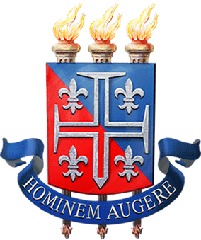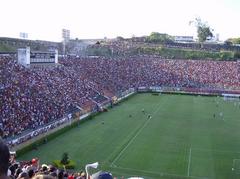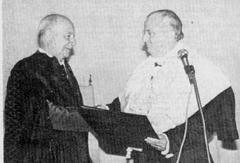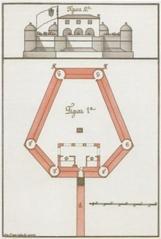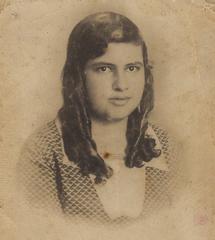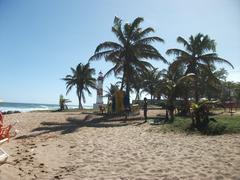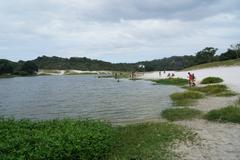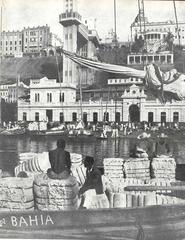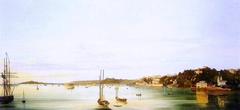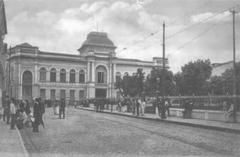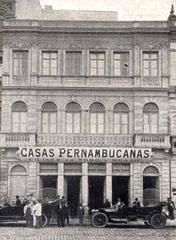Comprehensive Guide to Visiting Largo do Pelourinho, Salvador, Brazil
Date: 24/07/2024
Introduction
Largo do Pelourinho, situated in the historic center of Salvador, Brazil, is a site of profound historical and cultural importance. Known for its vibrant atmosphere, colorful colonial architecture, and rich history, Largo do Pelourinho offers a unique and enlightening experience for visitors. Founded in 1549, Salvador was Brazil’s first capital and one of the oldest colonial sites in the Americas, making its historic center a treasure trove of baroque colonial architecture, which earned it UNESCO World Heritage Site status in 1985 (Google Arts & Culture). This guide aims to provide comprehensive information about visiting Largo do Pelourinho, including its historical significance, architectural marvels, and practical visitor information such as visiting hours, ticket prices, and travel tips. By exploring this culturally rich destination, visitors can gain a deeper understanding of Brazil’s colonial past and its vibrant Afro-Brazilian heritage.
Table of Contents
- Introduction
- Historical Background
- Visitor Information
- Safety Precautions
- Navigating the Area
- Cultural Etiquette
- Must-See Attractions
- Culinary Delights
- Entertainment and Nightlife
- Shopping and Souvenirs
- Practical Information
- FAQ
- Conclusion
Historical Background
Early Colonial Period
Largo do Pelourinho, located in the historic center of Salvador, Brazil, is a site rich in history and cultural significance. Salvador, founded in 1549, was the first capital of Brazil and one of the oldest colonial sites in the Americas. The city’s historic downtown, known as Pelourinho, received UNESCO World Heritage Site status in 1985 due to its well-preserved baroque colonial architecture (Google Arts & Culture).
The Slave Trade and Public Punishments
Pelourinho’s history is deeply intertwined with the transatlantic slave trade. Salvador was home to the first slave market in the Americas, established in 1558. The square itself, Largo do Pelourinho, was named after the pelourinho, or whipping post, where enslaved Africans were publicly punished. This grim history is a stark reminder of the brutal realities of slavery that brought a significant African population to Brazil (Harvard Review).
Architectural Significance
The architectural landscape of Pelourinho is a testament to its colonial past. The area boasts a collection of 17th and 18th-century buildings, many of which have been restored to their former glory. These buildings are characterized by their colorful facades, tiled roofs, and wooden doors. The preservation efforts, primarily funded by local and state governments, have focused on maintaining what UNESCO described as “the most important collection of baroque colonial architecture in the Americas” (Harvard Review).
Restoration and Preservation Efforts
Since receiving UNESCO World Heritage status, Pelourinho has undergone significant restoration and preservation efforts. These efforts began in earnest in the early 1990s under the governance of Antonio Carlos Magalhães, who aimed to clean, preserve, and make Pelourinho a safer place for both locals and tourists. The restoration work has been ongoing, with a focus on preserving the cultural and historic heritage of the area (Lonely Planet).
Social and Economic Challenges
Despite the extensive restoration efforts, Pelourinho faces significant social and economic challenges. The contrast between the well-preserved historic center and its surrounding areas is stark. While the central area is bustling with boutiques, artisan shops, cultural institutions, restaurants, and hotels, the periphery suffers from social inequalities and security problems. Many buildings in the surrounding streets are abandoned and in disrepair, highlighting the ongoing issues of spatial segregation and cultural inequality (Harvard Review).
Cultural Significance
Pelourinho is not just a historical site; it is also a vibrant cultural hub. The area is home to numerous cultural centers, schools of music, dance, and capoeira, which are housed in the pastel-colored colonial buildings. These institutions play a crucial role in preserving and promoting Afro-Brazilian culture, which is a significant part of Salvador’s identity. The cultural activities and events held in Pelourinho attract both locals and tourists, making it a lively and dynamic part of the city (Lonely Planet).
Notable Landmarks
Several notable landmarks in Pelourinho contribute to its historical and cultural significance. The Igreja de São Francisco, located to the south of Pelourinho, is a prime example of baroque architecture. The Convento do Carmo, to the north, is another significant historical site. Other important landmarks include the Museu Afro-Brasileiro, which houses a collection of Afro-Brazilian art and artifacts, and the Fundação Casa de Jorge Amado, dedicated to one of Brazil’s most famous writers (Lonely Planet).
Preservation vs. Gentrification
The preservation efforts in Pelourinho have sparked debates about gentrification and the displacement of local residents. While the restoration work has made the area safer and more attractive to tourists, it has also led to rising property prices and the displacement of low-income residents. This has raised questions about how to balance preservation with social justice and inclusivity. Architects and planners continue to grapple with these issues, seeking ways to preserve the historic heritage of Pelourinho while benefiting both locals and visitors (Harvard Review).
Visitor Information
Visiting Hours and Tickets
Largo do Pelourinho is open to the public throughout the year. Most attractions in the area, including museums and churches, generally operate from 9 AM to 5 PM. It is advisable to check the specific visiting hours of each site in advance. Ticket prices for the major landmarks like the Museu Afro-Brasileiro range from 5 to 10 BRL.
Travel Tips
Visitors are encouraged to wear comfortable walking shoes due to the cobblestone streets. It is also recommended to carry some local currency (BRL) for small purchases. Guided tours are available and can provide deeper insights into the history and significance of the area. Don’t forget to bring a camera to capture the vibrant colors and unique architecture.
Nearby Attractions
Pelourinho is located in the heart of Salvador’s historic center, making it easy to visit other nearby attractions such as Mercado Modelo, Elevador Lacerda, and the Cathedral of Salvador. These sites offer an extended glimpse into the city’s rich cultural and historical tapestry.
Accessibility
While the historic nature of Pelourinho means cobblestone streets and some uneven surfaces, efforts have been made to improve accessibility. Some landmarks are equipped with ramps and accessible facilities, but it is advisable to check in advance.
Special Events and Guided Tours
Pelourinho hosts various cultural events throughout the year, including music festivals, dance performances, and traditional African-Brazilian celebrations. Guided tours are available and can be booked through local tour operators or online platforms.
Photographic Spots
Pelourinho offers numerous picturesque spots perfect for photography enthusiasts. Notable spots include the colorful facades along Rua Alfredo Britto, the panoramic views from the Igreja de São Francisco, and the vibrant street art scattered throughout the area.
Safety Precautions
When visiting Largo do Pelourinho, safety should be a top priority. Salvador, while rich in culture and history, has areas that can be unsafe, especially for tourists. Here are some essential safety tips:
- Be Discreet with Valuables: Avoid displaying expensive jewelry, cameras, or large amounts of cash. If you need to use your phone, do so inside a shop or café to avoid drawing attention (World Nomads).
- Stay in Groups: Especially at night, it’s safer to stay in groups. If you feel uncomfortable or lost, trust your instincts and take a taxi to your destination (World Nomads).
- Avoid Certain Areas at Night: Do not visit city beaches or parks after dark as they are common sites for robberies. Stick to well-lit, populated areas (World Nomads).
- Be Cautious with Free Gifts: Panhandlers may offer you “free” gifts like necklaces or short performances. Politely decline if you do not wish to make a donation (Salvador Guidebook).
Navigating the Area
Largo do Pelourinho is easily walkable, but here are some tips to make your exploration smoother:
- Use a Map: A printable map can help you navigate the cobblestone streets and find key attractions (Salvador Guidebook).
- Wear Comfortable Shoes: The streets are cobblestoned and can be uneven, so comfortable walking shoes are a must.
- Stay Hydrated: Salvador’s climate can be hot and humid. Carry a water bottle to stay hydrated as you explore.
Cultural Etiquette
Understanding local customs can enhance your experience and help you interact respectfully with residents:
- Language: While Portuguese is the official language, many locals in tourist areas speak some English. Learning a few basic Portuguese phrases can be helpful and appreciated.
- Respect Local Traditions: Salvador is a hub of Afro-Brazilian culture. Respect local customs and traditions, especially during religious ceremonies and festivals.
- Photography: Always ask for permission before taking photos of people, especially street performers and vendors.
Must-See Attractions
Largo do Pelourinho is packed with historical and cultural sites. Here are some highlights:
- Casa do Carnaval: This modern museum, inaugurated in 2018, celebrates Salvador’s famous Carnaval with interactive exhibits (Salvador Guidebook).
- Igreja NS do Bonfim: Located a few kilometers north, this 18th-century church is famous for its colored ribbons and is a significant religious site (Lonely Planet).
- Museu Náutico da Bahia: Situated 3.14 miles away, this museum offers insights into the maritime history of Bahia (Lonely Planet).
Culinary Delights
Sampling local cuisine is a must when visiting Pelourinho. Here are some recommendations:
- Traditional Food Buffets: SENAC’s traditional food buffet offers a variety of Bahian dishes. Alternatively, Odoyá is another popular spot for regional cuisine (Salvador Guidebook).
- Street Food: Try local favorites like acarajé (deep-fried bean cakes), cocada (coconut candy), and tapioca crepes. Look for stalls frequented by locals for the most authentic experience (Travel Photo Discovery).
Entertainment and Nightlife
Pelourinho is known for its vibrant music and dance scene. Here’s how to make the most of it:
- Street Performances: Wander the streets to discover impromptu performances by local musicians and dancers. These spontaneous shows are a highlight of the Pelourinho experience (Travel Photo Discovery).
- Live Music Venues: Many bars and restaurants feature live music, especially samba and reggae. Check local listings for performances during your visit.
- Night Safety: Always take a taxi back to your accommodation after a night out, even if it’s more expensive. Your safety is worth the extra cost (World Nomads).
Shopping and Souvenirs
Pelourinho offers a variety of shopping options, from boutiques to street vendors:
- Local Crafts: Look for handmade crafts, including jewelry, textiles, and artwork. These make unique souvenirs and support local artisans.
- Bargaining: While some prices are fixed, bargaining is common in street markets. Be polite and reasonable in your negotiations.
Practical Information
Here are some additional tips to ensure a smooth visit:
- Currency: The local currency is the Brazilian Real (BRL). ATMs are available, but it’s wise to carry some cash for smaller purchases.
- Weather: Salvador is a year-round destination, but the winter months (June to August) can be rainy. Always carry sunscreen and a hat to protect against the sun (TripSavvy).
- Health Precautions: Stay hydrated and use insect repellent to protect against mosquito-borne illnesses.
FAQ
Q: What are the visiting hours for Largo do Pelourinho? A: Largo do Pelourinho is open 24/7, but it’s best to visit during daylight hours for safety.
Q: Do I need to buy tickets to visit Largo do Pelourinho? A: No, Largo do Pelourinho is a public square and free to visit. However, some attractions within the area may charge an entry fee.
Q: What is the best time of year to visit Salvador? A: Salvador is a year-round destination, but the best time to visit is during the dry season from December to March.
Q: Are there guided tours available? A: Yes, there are several guided tours available that offer historical insights and explore the cultural significance of the area.
Q: Is Largo do Pelourinho accessible? A: While some areas have cobblestone streets, efforts have been made to improve accessibility with ramps and accessible facilities at key landmarks.
Q: What nearby attractions can I visit? A: Nearby attractions include Mercado Modelo, Elevador Lacerda, and the Cathedral of Salvador.
Conclusion
Largo do Pelourinho stands as an enduring symbol of Salvador’s rich historical and cultural tapestry. From its colonial roots and pivotal role in the transatlantic slave trade to its vibrant Afro-Brazilian culture, Pelourinho offers a multifaceted experience that is both educational and deeply moving. The area is not just a historical site; it remains a lively cultural hub where music, dance, and traditional practices continue to thrive, attracting both locals and tourists alike (Harvard Review). Despite the challenges of preservation and gentrification, ongoing efforts aim to maintain the area’s historical integrity while promoting social equity (Lonely Planet). Visitors are encouraged to explore the cobblestone streets, engage with the local culture, and reflect on the historical significance of this UNESCO World Heritage Site. With careful planning, including checking visiting hours and ticket prices, and following safety guidelines, a visit to Largo do Pelourinho can be a memorable and enriching journey into Brazil’s past and present.
References
- Google Arts & Culture, “Pelourinho - Historic Centre of Salvador de Bahia,” 2021, source
- Harvard Review, “Salvador de Bahia: Pelourinho as Inclusive Heritage,” 2021, source
- Lonely Planet, “Pelourinho,” 2021, source
- Wikipedia, “Historic Center of Salvador,” 2021, source
- National Geographic, “Inside Guide: Salvador, Cradle of Brazil’s Afro-Brazilian Heritage,” 2021, source
- NPR, “Roots of Samba: Exploring Historic Pelourinho in Salvador, Brazil,” 2021, source
- Salvador Guidebook, “Pelourinho Salvador,” 2021, source
- World Nomads, “Safety Tips: Salvador, Brazil,” 2021, source

